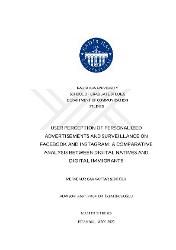User perception of personalized advertisements and surveillance on Facebook and Instagram: A comparative analysis between digital natives and digital immigrants
Abstract
The appearance of Web 2.0 has altered the nature of one-way traditional media which users were only the receivers and it allowed them to contribute to online platforms. Web 2.0 brought out new Internet technologies called as social media platforms such as Facebook, Twitter and Instagram etc. where the users can not only interact with other users, but also produce and share their own content on their profiles. According to a research carried in 2018, Facebook users spend approximately 50 minutes of their lives on Facebook daily and that makes it an appropriate investment platform for companies which want to reach further customers (Uluk, 2018). Intense usage of social media platforms led social media marketers use them as a tool to reach out their target customers through online advertisements (Aydın, 2016). As it is a competitive area, the marketers brought out the concept of personalized advertisement (Ouick, 2019). Showing people advertisements related to their interests requires personal information about that person and that means it requires tracking hem. As a result of gathering personal information about the users, the problem of surveillance emerges. In digital age, the Internet users are divided into two categories; digital native and digital immigrants as Prensky (2001) calls it. As Prensky (2001) suggested, the digital immigrants are the people who were born before 1980. However, demographic, financial and social differences are also important as well as age. Considering these differences and taking the age the users started to use the Internet technologies, this research aims to investigate the difference between digital natives and digital immigrants regarding their opinions about personalized advertisements and digital surveillance on Facebook and Instagram. Web 2.0'ın doğuşu, tek taraflı geleneksel medyanın yapısını değiştirerek kullanıcıların çevrimiçi platformlara katkıda bulunabildikleri bir ortam haline getirerek Facebook, Instagram gibi sosyal medya platformlarının da önünü açmıştır. Bu platformlarda kullanıcılar yalnızca diğer kullanıcılarla iletişim içine girmekle kalmamakta, kendi profillerinde kendilerine ait içerikler de paylaşabilmektedir. 2018 yılındaki araştırmaya göre Facebook kullanıcıları yaklaşık olarak günlük 50 dakika Facebook'da zaman geçirmektedir. Bu da daha fazla müşteriye ulaşmak isteyen şirketler için Facebook'u yatırım için uygun bir platform haline getirmektedir (Uluk, 2018). Sosyal medya platformlarının yoğun kullanımı, sosyal medya pazarlamacıları için çevrimiçi reklamları kullanarak hedef müşterilere ulaşmak adına uygun bir araç işlevi görmektedir. Rekabetçi bir alan olması sebebiyle, pazarlamacılar yeni bir yöntem olarak kişiselleştirilmiş reklamlar kavramını ortaya çıkardılar (Quick, 2019). Kişilerin ilgi alanlarına yönelik reklamlar göstermek aynı zamanda o kişileri izlemek anlamına da gelmektedir. Kullanıcılar hakkında kişisel bilgiler toplamanın sonucu olarak ise gözetim sorunu ortaya çıkmaktadır. Prensky'e göre (2001) dijital çağda, Internet kullanıcıları iki kategoriye ayrılır; dijital göçmenler ve dijital yerliler. Ona göre dijital yerliler doğumlarından itibaren teknoloji kavramına ve yeni teknolojik gelişmeler aşina olarak büyürler. Ancak bu ayrımda yaşın yanı sıra demografik, finansal ve sosyal farklılıklar da önem arz etmektedir. Burdan yola çıkarak bu araştırma, internet teknolojilerini kullanmaya başladıkları yaşı baz alarak, dijital yerliler ve dijital göçmenlerin, Facebook ve Instagram üzerinde gerçekleşen kişiselleştirilmiş reklamlar ve dijital gözetim hakkındaki tutumlarını araştırmak amacıyla çevrimiçi anket olarak hazırlanmıştır.
Collections
- Tez Koleksiyonu [1348]
Related items
Showing items related by title, author, creator and subject.
-
"We will fix it in post", but how will we fix post? Digital post labor processes in Turkey's film industry
Duman, Oya Aytimur (Kadir Has Üniversitesi, 2018)Digital cinema has been one of the most groundbreaking technological innovations since the invention of cinema and has been a remarkable area of study with the multifaceted alterations it has led to in film theories and ... -
Cultural heritage - its digital preservations, and collateral damage
Kahraman, Baran (Kadir Has Üniversitesi, 2022-12)The fundamental goal of this thesis is to examine the relationship between cultural heritage and 3D visualizations of them, stretching and challenging the definition of simulacra in order to better understand what role the ... -
Challenging the influence of interactivity on narrative structures in digital games. An analysis of adventure genres
Yavuz, Nilufer Zeynep (Kadir Has Üniversitesi, 2018)This study analyzes the narrative structure of the computer games after the emergence of the computer technology which provides an opportunity for the game designers to create more extensive narrative structures. The aim ...
















